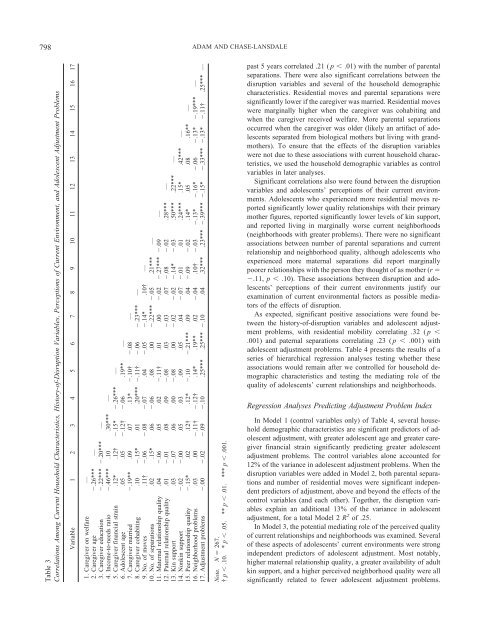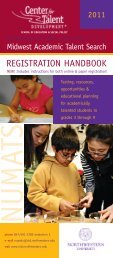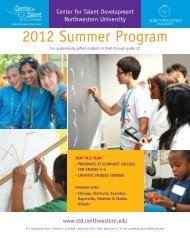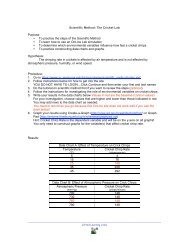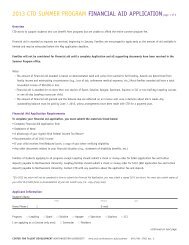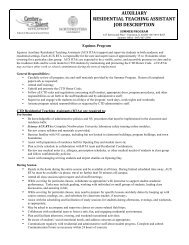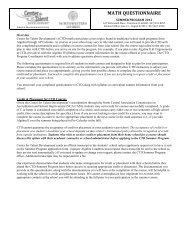Home Sweet Home(s): Parental Separations, Residential Moves ...
Home Sweet Home(s): Parental Separations, Residential Moves ...
Home Sweet Home(s): Parental Separations, Residential Moves ...
- No tags were found...
You also want an ePaper? Increase the reach of your titles
YUMPU automatically turns print PDFs into web optimized ePapers that Google loves.
798 ADAM AND CHASE-LANSDALETable 3Correlations Among Current Household Characteristics, History-of-Disruption Variables, Perceptions of Current Environment, and Adolescent Adjustment ProblemsVariable 1 2 3 4 5 6 7 8 9 10 11 12 13 14 15 16 171. Caregiver on welfare —2. Caregiver age .26*** —3. Caregiver education .22*** .20*** —4. Income-to-needs ratio .46*** .10 .30*** —5. Caregiver financial strain .12* .12† .15* .26*** —6. Adolescent age .05 .05 .12† .06 .19** —7. Caregiver married .19** .09 .07 .13* .10† .08 —8. Caregiver cohabiting .10 .15* .01 .20*** .11† .06 .23*** —9. No. of moves .11† .06 .08 .07 .04 .05 .14* .10† —10. No. of separations .02 .15* .06 .06 .08 .00 .22*** .05 .21*** —11. Maternal relationship quality .04 .06 .05 .02 .11† .01 .00 .02 .27*** .09 —12. Paternal relationship quality .01 .01 .08 .09 .08 .03 .03 .07 .08 .02 .28*** —13. Kin support .03 .07 .06 .00 .08 .00 .02 .02 .14* .03 .50*** .22*** —14. Nonkin support .02 .00 .05 .03 .09 .05 .04 .07 .01 .01 .24*** .15* .42*** —15. Peer relationship quality .15* .02 .12† .12* .10 .21*** .09 .04 .09 .02 .14* .05 .08 .16** —16. Neighborhood problems .03 .00 .11† .12† .14* .19** .02 .04 .10† .03 .13* .16* .06 .13* .19*** —17. Adjustment problems .00 .02 .09 .10 .25*** .25*** .10 .04 .32*** .23*** .39*** .15* .33*** .13* .11† .25*** —Note. N 267.† p .10. * p .05. ** p .01. *** p .001.past 5 years correlated .21 ( p .01) with the number of parentalseparations. There were also significant correlations between thedisruption variables and several of the household demographiccharacteristics. <strong>Residential</strong> moves and parental separations weresignificantly lower if the caregiver was married. <strong>Residential</strong> moveswere marginally higher when the caregiver was cohabiting andwhen the caregiver received welfare. More parental separationsoccurred when the caregiver was older (likely an artifact of adolescentsseparated from biological mothers but living with grandmothers).To ensure that the effects of the disruption variableswere not due to these associations with current household characteristics,we used the household demographic variables as controlvariables in later analyses.Significant correlations also were found between the disruptionvariables and adolescents’ perceptions of their current environments.Adolescents who experienced more residential moves reportedsignificantly lower quality relationships with their primarymother figures, reported significantly lower levels of kin support,and reported living in marginally worse current neighborhoods(neighborhoods with greater problems). There were no significantassociations between number of parental separations and currentrelationship and neighborhood quality, although adolescents whoexperienced more maternal separations did report marginallypoorer relationships with the person they thought of as mother (r .11, p .10). These associations between disruption and adolescents’perceptions of their current environments justify ourexamination of current environmental factors as possible mediatorsof the effects of disruption.As expected, significant positive associations were found betweenthe history-of-disruption variables and adolescent adjustmentproblems, with residential mobility correlating .32 ( p .001) and paternal separations correlating .23 ( p .001) withadolescent adjustment problems. Table 4 presents the results of aseries of hierarchical regression analyses testing whether theseassociations would remain after we controlled for household demographiccharacteristics and testing the mediating role of thequality of adolescents’ current relationships and neighborhoods.Regression Analyses Predicting Adjustment Problem IndexIn Model 1 (control variables only) of Table 4, several householddemographic characteristics are significant predictors of adolescentadjustment, with greater adolescent age and greater caregiverfinancial strain significantly predicting greater adolescentadjustment problems. The control variables alone accounted for12% of the variance in adolescent adjustment problems. When thedisruption variables were added in Model 2, both parental separationsand number of residential moves were significant independentpredictors of adjustment, above and beyond the effects of thecontrol variables (and each other). Together, the disruption variablesexplain an additional 13% of the variance in adolescentadjustment, for a total Model 2 R 2 of .25.In Model 3, the potential mediating role of the perceived qualityof current relationships and neighborhoods was examined. Severalof these aspects of adolescents’ current environments were strongindependent predictors of adolescent adjustment. Most notably,higher maternal relationship quality, a greater availability of adultkin support, and a higher perceived neighborhood quality were allsignificantly related to fewer adolescent adjustment problems.


